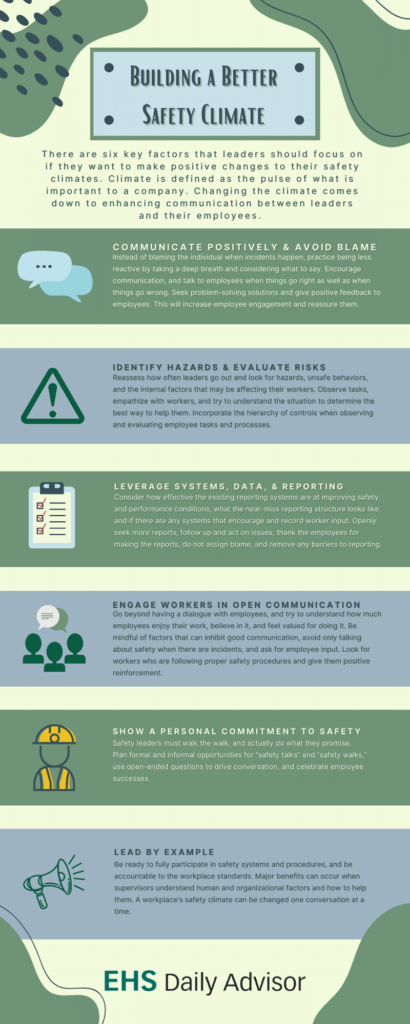Share with your commercial clients how they can improve their safety climate
- What’s “safety climate?” Worker perceptions of safety on a jobsite.
- Safety climate also determines whether workers feel empowered to raise safety concerns.
- View the infographic for six steps to improve your safety climate.
Construction safety has improved dramatically in the past few years. Many companies have very good safety programs, but there is still significant room for improvement. Some 900 construction workers annually are killed on the job in the United States; thousands more sustain serious injuries or suffer from chronic illnesses. Whether your insurance client is in construction, warehousing or manufacturing, it’s crucial that they continuously improve their safety climate. Share this infographic with them.
Compliance with OSHA standards is not enough: further safety improvements need to come from addressing both the physical exposures and psychosocial aspects of safety on the jobsite. Safety climate has been defined as the worker perceptions of safety on the construction site.
What is safety climate?
The safety climate of a jobsite determines whether workers feel empowered to raise safety concerns. By improving safety climate (e.g. worker perceptions of safety on the jobsite), safety will be seen as a fundamental part of the job and safety will improve. If workers aren’t comfortable raising safety issues or concerns, then problems won’t be addressed and injuries are inevitable. If supervisors and forepersons don’t communicate the importance of safety through their words and actions, workers will get the message loud and clear that safety isn’t important.
Safety is not a goal, says the American Industrial Hygiene Association (AIHA), but a journey of continuous improvement, taking steps to improve their safety climate. It depends as much on how it is accomplished as on the rules and standards. Construction is a fluid, dynamic process with many moving parts. The only way to assure safety is to get everyone working together. Not engaging workers actively in the safety program is a missed opportunity to identify risks and implement controls that may not be possible at later stages of construction.
Download our free eBook to help your workers’ comp clients lower their premiums.
How to improve your safety climate? Involve front-line workers
Construction workers are often conditioned to accept risks associated with their work and focus on getting the job done, even when they have personal concerns about their safety. Front- line workers are often blamed for incidents on the jobsite by being “careless.” However, asking workers to actively engage in identifying workplace hazards, problem-solving and recommendations for alternative work methods will signify a distinct safety focus.
Employers are legally responsible for insuring worker safety, but workers are usually the first to find or know about a hazardous condition or situation. If they are actively engaged in the safety process, hazards can be identified and corrected before someone gets hurt. The ideal is that every worker becomes a safety leader — not simply leaving it up to the safety manager or supervisor. All workers need to know what hazards to look for, to feel comfortable reporting them and to be encouraged to do so without fear of retaliation.
Below are six ways to improve your safety climate on a worksite, whether it’s a construction, manufacturing or warehousing site, courtesy of EHS Daily Advisor.


![You are currently viewing How to improve your safety climate [infographic]](https://www.arrowheadgrp.com/wp-content/uploads/2022/04/AH-4.26-injured-worker-BLOG.png)